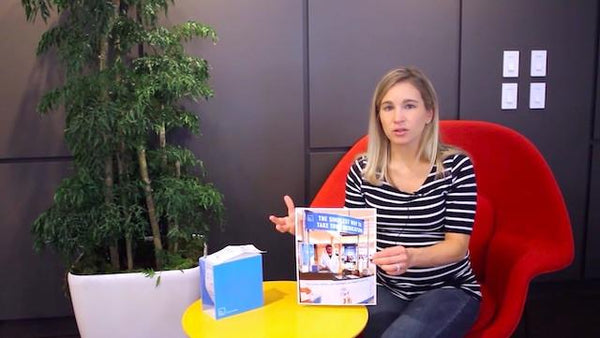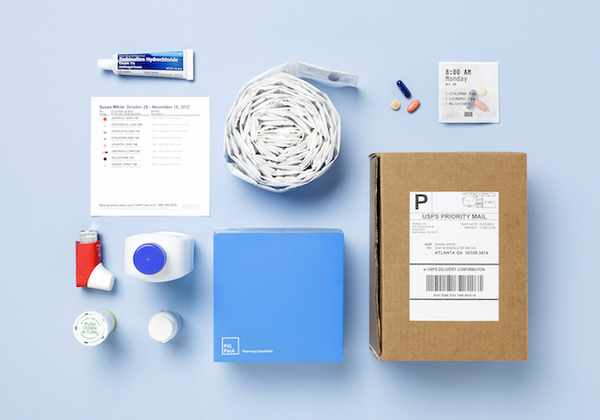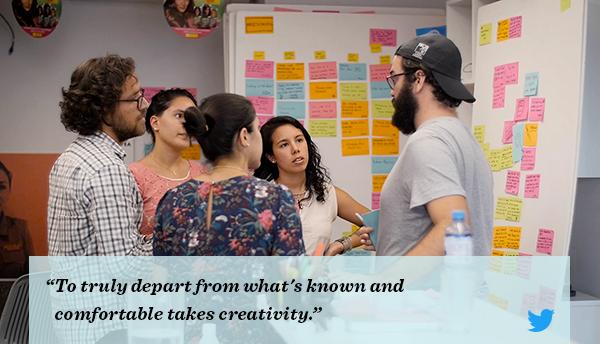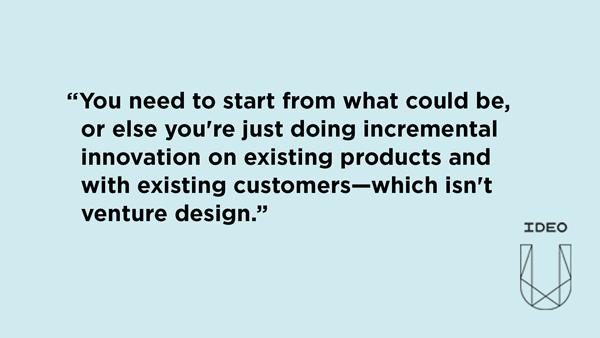Turning Creative Ideas into Viable Companies
As IDEO Cambridge Portfolio Director, Katherine Londergan works with companies of all sizes to bring new innovations to life. Katherine shares with us how her team uses venture design to move from hypothesis to testing and prototyping, to rapid iterations.
With an MBA in Entrepreneurship from Babson College and a Liberal Arts degree from Georgetown University, Katherine brings a breadth of entrepreneurial and design experience to both large companies looking for new growth and startups preparing for launch.

Tell us a little about yourself and what you’re doing at this point in your career.
I'm a portfolio director in our IDEO Cambridge studio. My focus is designing new ventures for startups and large companies looking for transformational growth beyond just a product or service. It means designing, testing, and launching all aspects of a new business including the brand, business model, products/services, user experience, and organization. Typically we are helping companies pursue a new customer with a completely new value proposition.
I spend most of my time guiding teams and trying to push the ways we work to be scrappier and more hypothesis-driven in designing these new ventures.
How do you come up with the hypothesis?
When we're working in venture, often times we have a hunch or a founder has a hunch they want to explore. There’s some passion and some momentum behind an idea when they arrive to do the project. It’s a little different than our typical IDEO process where we may start with a broad question like, "How might we sell our product to Millennials?" or, "How might we change our services for a particular market?" This is much more, "We think there is an opportunity to do X" and so it's about designing that value proposition and testing it with users to achieve product-market fit earlier.
For instance, PillPack was a startup in residence out of IDEO Cambridge, who arrived with a proof of concept and needed their service designed in preparation for launch. Our work with the founding team was about establishing their brand and expressing what they stood for through every touchpoint of the experience. We had some early hypotheses that allowed the team to prototype and test different aspects of the business in some early, tight cycles. This helped us get further in the design process, and make fast decisions around where PillPack would deliver the most value to customers.

How do you use prototyping in venture design?
In most cases, we try to be closer to the market, which may mean live prototyping or co-creating the venture with its users. In one instance, we were trying to nail the messaging around PillPack’s service and struggling with distilling it for people. We did an exercise with users where we co-created website headlines, imagery, and content based on what they found was most compelling. PillPack.com’s layout is a series of rectangles that you scroll through. In the exercise with users, we had several prototypes of each rectangle (and some blank rectangles) and asked users to build their own website from top to bottom. We edited the copy together and used their words to talk about the service as if explaining it to a friend—instead of PillPack trying to explain itself. As a result, it was more conversational and straightforward and people understood exactly what they were getting from the pharmacy.
In another prototype, we were exploring messaging and what we should charge for the service when PillPack launched. We had a hunch that it was around $19 or $20 per month, but we were wondering if it could be more or less than that. One approach would have been to run a survey or a more quantitative test, but we also wanted to show the PillPack team the richness of prototyping and getting feedback in market real-time. We decided to spend $1500 for a booth at the mall for the weekend and took turns manning the booth. We tested pricing of $9/month on Friday, $19 on Saturday, and $29 on Sunday and had conversations with people around how that felt. We found out pretty early on that $9 was too little, $19 felt pretty right on, and $29 was too much. It also allowed us to consider how to talk about the service and what messages to lead with. (Note: PillPack launched charging only co-pays, not with this additional fee; the service itself is free.)
Through speaking with people, we uncovered insights like the fact that people didn't know that PillPack was a pharmacy. Some thought it was just a packaging or delivery company, but the fact they are a full-service pharmacy wasn’t completely clear. We knew we needed to dial that up in communication.
We did use digital prototyping tools as well with PillPack. For value prop message testing we find Facebook to be effective; it helped us direct our message and figure out how cheeky we could be for something that, at the end of the day, is about medicine. While we did get some statistical significance from Facebook clicks that showed what messaging resonated most, the biggest value of Facebook turned out to be people’s conversations in the comments below our sponsored post.
We had one sponsored post where over 50 people commented, and it was super interesting in helping us figure out who the target market was. There were people who commented on the ad and said, "You know, this seems like a lot of waste in packaging and it seems unnecessary. Just what we need. More trash in America." Others responded and mentioned people they cared for and how critical taking the right medication at the right time was. I can’t remember the exact quote, but it was something like, "My medically ill daughter cannot lead a normal life if she forgets a dose.” It was amazing to see people raising their own hands and defending this service that didn't yet exist. At this point, there was barely a website. It's interesting what you can learn by putting a very crisp message into the conversation that’s happening on social media.
How do you know when a prototype is working and what are the measurements to put behind a prototype?
When we’re looking for metrics and evidence from users, it’s often more visceral, qualitative, and emotional because we’re prototyping and creating experiences in tight cycles. Quantitative metrics are important, but you can't strip out the emotions, the reaction, and the things that users can't put into a number. We have a lot of rigor around what the question is we're trying to answer and what we should make in order to test that and we are measuring things as we go. But we tend to be so close to the user that we know earlier what’s working and what’s not. We don't wait for the data to roll in. We're living it with them and trying to iterate on the fly as much as we can.
It also relies on designer’s intuition and synthesis on the go—where we're learning and iterating faster. When you see an IDEO team that’s in their flow, they’re making and testing and iterating at a pretty intense rate and they know what questions they're trying to answer. Once the answer becomes obvious they move onto the next aspect of the design, to answer a new question. They're not going to draw out an experiment. They're going to use anytime they have remaining to make the idea or the experience even better. As the answers show themselves through users’ feedback, we bring that evidence and those stories to our clients and they agree pretty quickly.
It's because we have a deeper engagement with the users. It’s not just a binary yes or no. It's why it's working, how it's working, how it's impacting their lives, having them use it, having them live with it. It’s a different level than, "Is this a yes or a no? What are we measuring?"
Why do you think the world needs creativity now more than ever?
Our most exciting work, in my opinion, is when we're creating the new new. You can't hold onto a core business and strangle it. You can only optimize what’s known and hold onto what’s expected for so long—to truly depart from what's known and comfortable takes creativity. When you’re trying to spin up entirely new value propositions, entirely new businesses, it demands a more generative approach. You need different inputs and methods to inspire that process. You need to start from what could be, or else you're just doing incremental innovation on existing products and with existing customers—which isn't venture design.
What’s something you're working on now with your personal leadership style?
I'm trying to help our teams be more creative in the ways we work on projects. So, we're trying more cross-pollination between teams. A well-placed design boost or charrette can change the course of the project or really give it an unfair advantage. There’s a freshness of getting new people to look at a problem. Usually, a project team will invite others in throughout the project, but I’m looking for ways to truly shake that up and get more people involved. The goal is to create ways to get the whole studio to touch the design of a new venture. That's something I'm doing in Cambridge right now on a few projects.
If you had a magic wand to design a world where anyone could build creative confidence to solve real world challenges what would you change?
I would give people tools to be entrepreneurs so they can build their ideas to be sustainable out in the world. If people could learn enough about entrepreneurship and the viability side of their ideas, their creativity can be sustained and work within the physics of our economies. Many people that want to create impact have great ideas but don’t have the tools to make them into real businesses with a viable business model. For a creative idea to live it can't always just be creative for creative's sake. It needs to make business sense so that it can have staying power.
Learn how to prototype and design every aspect of your business in our online course, Designing a Business.
- choosing a selection results in a full page refresh
- press the space key then arrow keys to make a selection






